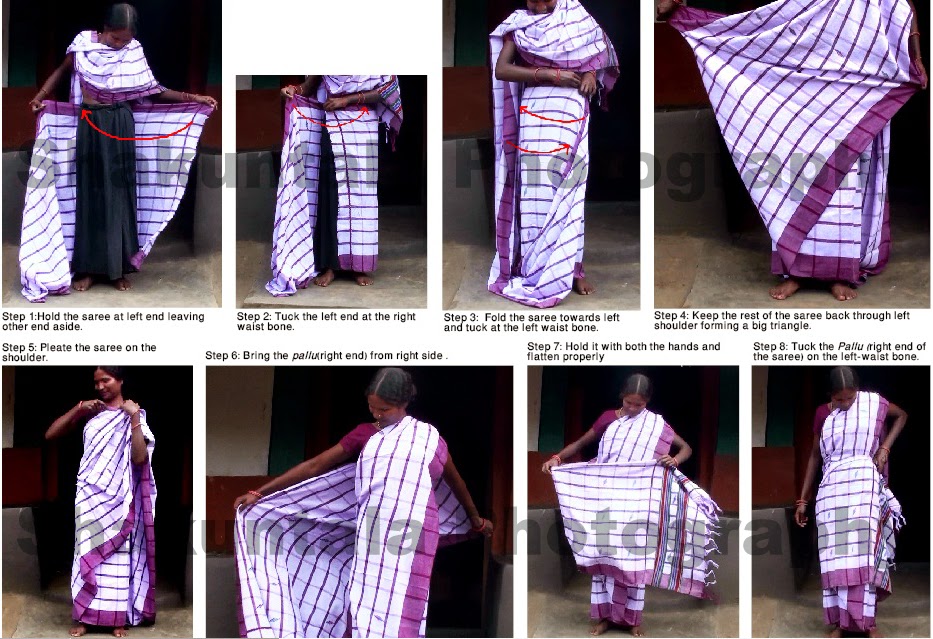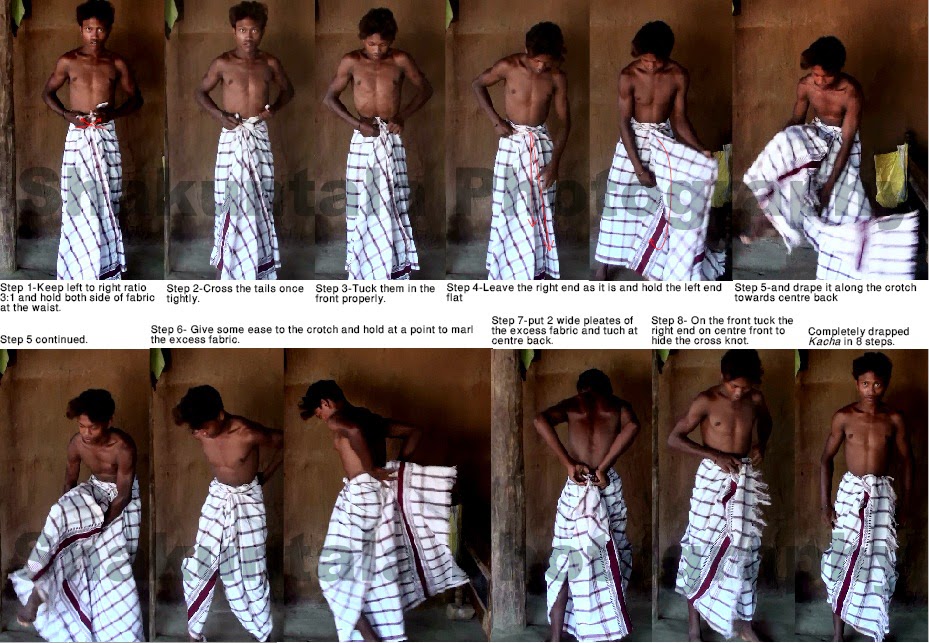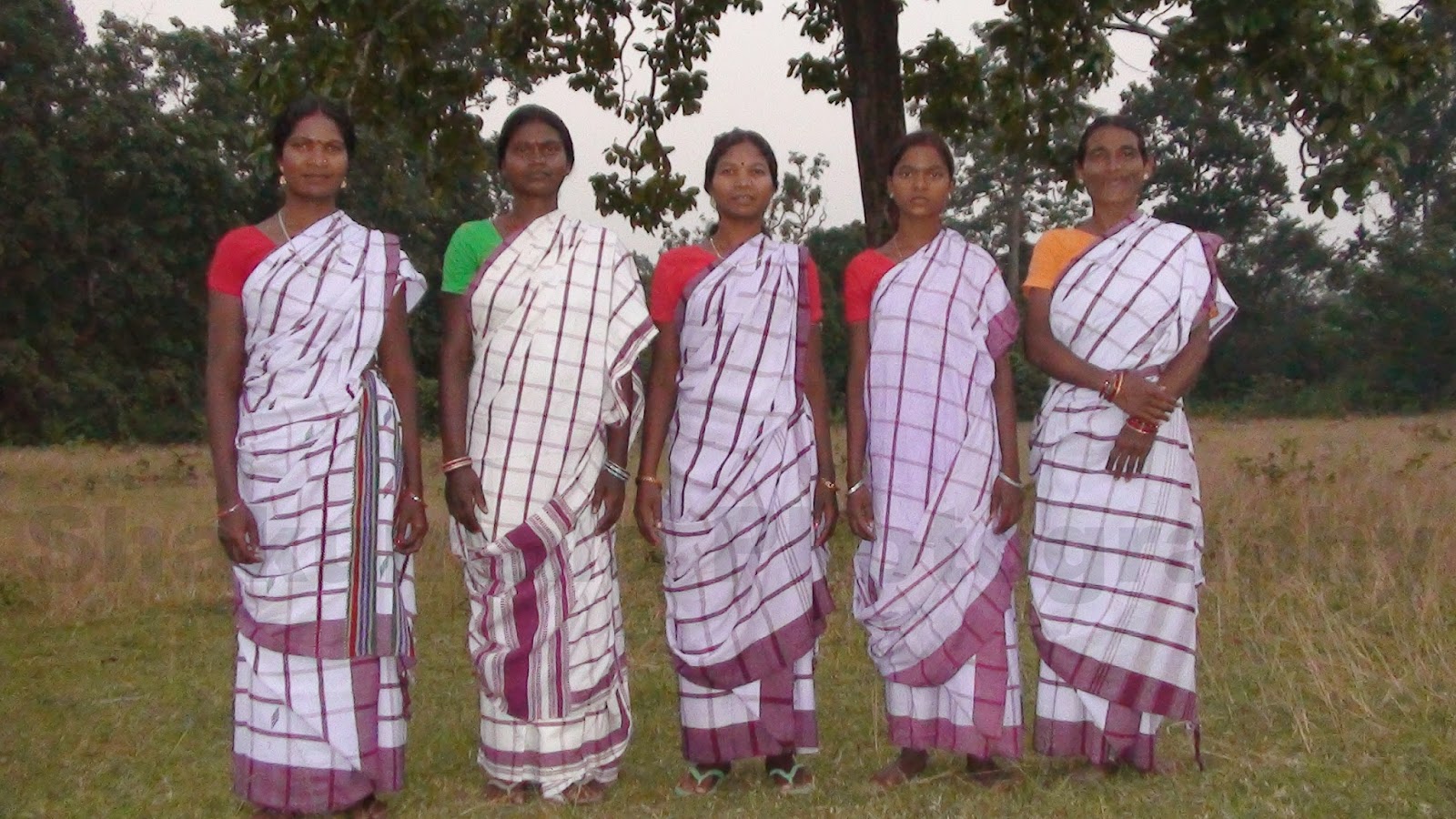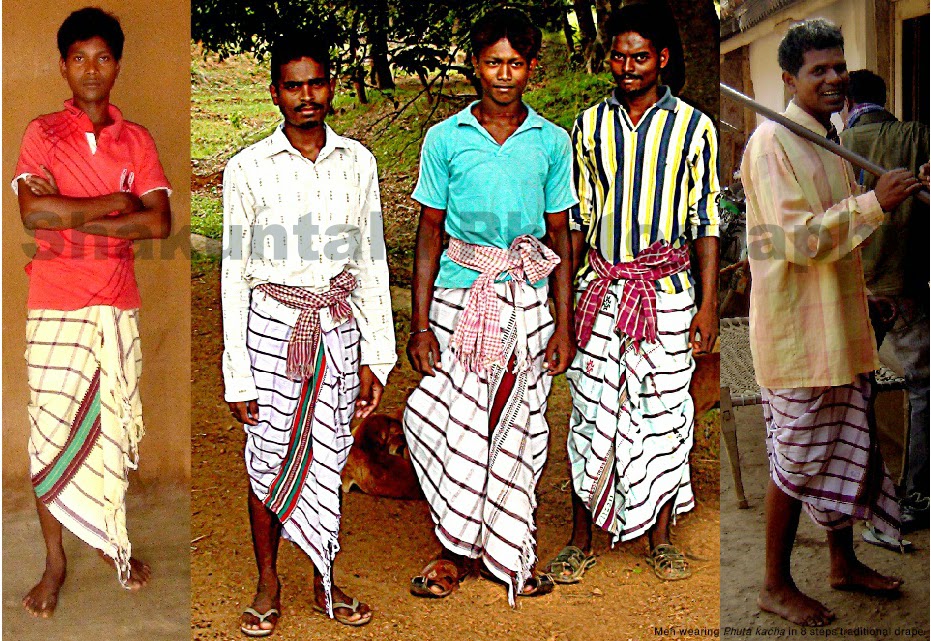 |
| Me serving handi to my (L)-father's paternal aunt, (R)- Father's cousin brother |
Santal people are very simple in nature and behavior. Their lifestyle is The santals have their own clothings and distinctive draping styles. Now days people wear the sarees and dhotis what ever available in market. How ever they prefer cotton material for daily use and synthetic sarees with good drape for occasional use.Women wear petticoat,saree and blouse. But the old ladies rarely wear blouse as everyday clothing. children wear shirt, pants what ever is available in the market. There is no such traditional garment existing for children now a days. In earlier days children wore Langot a loin cloth to cover their private parts. Male wear a lungi- a rectangular cloth at bottom and a vest or shirt on top. Usually men hold a gamchha almost all time. Either they tie the gamchha on the head or on waist.
•Clothing History of Santals:
In earlier days Santals used to wear very simple cotton clothes. For women there was a two piece cloth called palhand (on bottom) and panchi(top). It was being used without petticoat and blouse. Though there was difference in the length of the materials according to the requirements.
It is said that in earlier days santals cultivated cotton along with rice and some other grains. They were aware of spinning yarns in takli. They used to spin yarns and give it to the local weavers to weave loin cloths.
In earlier days the women were going to dense jungle to bring fruits and leaves. It was kind of a daily routine for them. It is easier to move forward if you wear small and tight cloth. So the women wore the palhand and panchhi for better comfort.
The palhand had a width of 3ft just to wear below the knee and length of 5ft. the panchi was of 4ft long and 2 ½ ft wide. Neither palhand nor the panchi had colored borders on it even though there was selvedge on both edges.
The palhand was wrapped on the waist tightly and folded from one side of the waist to another in the front with the excess length. The panchhi was tucked on the waist inside the bottom wear in the front then moved around back and put on the left shoulder. The extra fabric was again pulled to the front and tucked on the left side waist. The panchhi was being used more functionally. That time people did not carry bags to keep stuffs in it, they make a pouch of the panchhi by tucking it both the sides on waist and keep stuffs in it. When they return from the jungle they just tie knots to close the pouch during returning to home. The panchhi gets dirty more quickly as it is used as a bag and also can be washed separately likewise. Some times the cloth gets stains because of the fruit juice which does not get clean easily. This context made it logical to wear a two piece cloth, because it was not affordable for them to buy new cloths frequently. The men wore the kachha which was 5 ½ ft long and 3ft in width. They wore the kachha in the same style as it is worn today.
With gradual improvement of economical condition women started using saree supplied by the weavers. The length was then 12ft and width 3 ½ ft. For few time the women wore the white saree with no coloured borders until they know the colouring of yarn. When they knew about dyeing the yarn they either spun it them selves or bought it from the local market, then dyed it and gave the colored yarn to the weavers. They used aal as the main ingredient for dyeing with harida and danguapaan.
Here are some terms used to calculate the yarn length/bundle during purchasing in local market:
1 lati = 20rounds of yarn with 1 1/2ft fold= 60ft
1 fandi = bundle of 5 lati=300ft
1 machad = 12 fandi=3600ft = 1098m
And the prices were
20s count- Rs4/ machad
40s count- Rs6/ machad
60s count- Rs10/ machad
The Aal tree is seen almost all forests of Tamilnadu,Andhra Pradesh, Karnataka, Orissa, Jharkhand and West Bengal. The bark and root of the tree is being used as textile dye stuffs from long years in most of the places of tamilnadu, Gujarat, Jharkhand and Orissa. In Jharkhand and Orissa it is mostly practiced by the tribal people of santal and Munda.
From past 120 years the santals of Orissa are in practice with this work but from the current young generation no one carried on the techniques. One more problem is that every family had their own recipe and proportion of dyestuffsfor the dye bath and it was kept secret in the family members. They did not do it for commercial purpose but for the family. Even though their process was different they were all doing the same dark maroon color which have become quite significant among todays santal culture.
after the use of dyeing process, the clothing of santals came with a distinct check pattern and wide borders. Bassed on these patterns there are some sarees and dhotis specially used in marriages. The sarees and dhotis vary in sizes ,they are described below in detail.
a: Khanda Lugli – width 3 1/2ft. length- 16,17,18ft as per order.
This saree is offered to the mother of the bride.
Dyed yarn pattern- 2 ½ inch border on both side of the saree in warp direction and in pallu 3 wider stripes of 2 ½ inch.
 |
| Khanda Lugli |
b: Gagla Lugli: width 3 ½ ft and length 17/18 ft.
Dyed yarn pattern: 2 ½ inch border in both the selvedges and 1 ½ inch line next to the wide borders and pallu same as the khanda lugli.
This is offered to the bride’s aunt(father’s sister).
c: Hele Lugli: width- 3 ½ ft. length 11 to 12 ft.
Dyed yarn pattern same as khanda lugli only the length differs. Hele lugli is offered to the mother’s mother of the bride during marriage.
d: Sindur lugli: male- width 3 ½ ft and length 6 ft
Female- width 3 ½ ft and length 9ft.
These are plain dhotis and sarees. They are dyed with turmeric and dried in sun just before one day of use. Worn by the bride and the bride groom during the main ritual of the marriage. It is also available with 1/2” red border at sevvedge and 1/4” line at both ends.
 |
| Sindur Lugli |
e: Turban for male: width 2 ft and length 6ft. it comes with 1 ½ inch red border in both selvedges.this is a solid white cloth and turmeric is not applied to it before use. It is used by the bride groom.
f: sada kacha: width 3 ½ ft and length 6ft.
I does not have any colored borders. This is offered to the village head man and two members of the higher authority in the village of the bride’s side.
g:Phuta kacha: male: width 3 1/2ft and length5½ ft.
It has the typical Santali check on the body.This is offered to the match maker of the marriage and rest of the family members of the brides family if any.
Other than marriage offerings, it is worm during many festivals and social gatherings like Guru Mahit, bejha tunj during Sakrat and Punei parab. and In earlier days the kachas were available only in white base and dark maroonish check pattern but now a days some more colored yarns like red, blue and green are used both in warp and weft directions.
 |
| Phuta. Kacha |
h:Jha.lah: Female: width 3 ½ ft and length 15ft.
This also has the Santali check on the body, some stripe work on the pallu. This saree is offered to the wife of the match maker and the female members of the bride side.
It is also worn by the Santal women in many other occassions same as phuta kacha.In special occasions male and female wear phuta. kacha and jha.lah respectively.Now a days people are more conscious about their community. So when ever there is a community meeting, awareness camp or some other social gathering they make it a point to wear these specific clothing.
 |
| Jha.lah |
Differenes and similarities between phuta kacha and jhalah:
The phuta kacha is vertically symmetric as it has both the ends designed with same motifs, it can be worn in both the ways where as the jhalah is asymmetric with one end generally ending with stripe patterns or three close stripes and the other end(pallu) heavily embelished with floral motifs and grids.The check pattern in both the phuta. kacha(dhoti) and the jha.lah(saree) are same but the length differs. Initially there were no motifs on the sarees and dhotis.But now a days both the sarees and dhotis come with some motifs of birds,fishes,flowers,leaves and animals. The motifs are derived from the matters surrounding them. Generally the sarees have motifs on the pallus and sometimes on the borders. The dhotis have very rare motifs on the body but both the end are designed with colorful motifs now a day.The pallu of the sarees have floral motifs and wider stripes in the width of around 2 1/2 ft. where as the phuta. kacha has srtipes with comparatively narrow width. The jha.lah has prominent wide border on both the selvedges where as in futa kacha the check pattern continues till the selvedges.
•Draping
Draping is the process of hanging generally the textile materials from a fixed position giving a proper fall to it. In clothing the terminology is used as the process of wearing a loin cloth around ones body with the ease of comfortability.
In ancient days the people draped two piece of loin cloth to cover their sensitive parts. They fixed the cloths on the waist and chest with some bones and strings as the fasteners.This is supposed to be the oldest use of draping.With change in time size of the loin cloth has but not the concept of draping. Now we call the loin cloths as sarees(worn by women) and dhoti(worn by men).There are various types of draping sarees followed in India varies from state to state. A marathi woman drapes the same length of saree completely different from a Bengali woman does. Draping most of the time varies according to the daily work of a wearer. More the physical work tighter the drape. Even a single person changes the drape of the single saree many a time in a time according the work she performs in a day. Here we have shown the typical drapes followed by Santali men and women with step by step illustration.
 |
| 8 Step Santali saree draping |
 |
| 8 Step Santali Kacha draping |
•Wash and Care of clothings:
The people in the village are very conscious about the neatness of their clothes.now a days they clean clothes with detergent but when they clean their bed spreads, kanthas and heavy cotton materials they use ash. Generally the people clean their clothes and take bath in river or ponds. During washing with ash, water is first boiled with ash powder in it and stirred for some time.
 |
| Sarees hung on wire to dry after washing |
 |
| Cloths put on wooden fencing to dry |
To protect the clothes from moth, people keep some pieces of camphor in the box of clothes. In earlier days they used to keep their clothes in bamboo made boxes called ‘pitaree’. Now a days they use wooden and tin boxes to keep the good clothes and other valuables.
 |
| Village women in traditional jha.l saree drape |
 |
| Village men in traditional phuta. kacha drape |
keep it up...
ReplyDeletehey thanks.....
ReplyDeleteIt is an effort to document the tradition....
If u see any faults in the description, suggestions are always welcomed.
Regards
Shakuntala
Nice post...keep it up
ReplyDeletevery nice...thanks it helped...mostly the pictures were gud...!!!
ReplyDeleteThank you sir.
DeleteGood info. great work .... keep it up... thanks...
ReplyDeleteNice effort...
ReplyDeleteAwsme helped me a lot to know my culture..
ReplyDeleteAwsme.... Helped me a lot to know my culture thanks.
ReplyDeletehi
ReplyDeletewhere can onefind these santhali sarees ....very very interested
hi
ReplyDeletewhere can onefind these santhali sarees ....very very interested
visit to www.santalbazar.com this type of saree,kacha and other clothe are found here.
ReplyDeleteSuch interesting information. Thank you.
ReplyDeleteHey...can i get these santhal sarees
ReplyDeleteHi,
DeleteThank you for visiting my blog. Sure
I can send you the saree, please specify which particular one you want.Right now I have green and white jha.lag with me. I have a small request.. who ever wears the saree should wear it with dignity.
Thank you
Regards
Shakuntala Marndi
Hello ma'am I am research student belonging from Jharkhand and doing my PhD programme from delhi.. can plz help me regarding tribal arts and culture .while going with Ur blog it helped me lots..how can I contact u plz reply so that information regarding my research can fulfill...
DeleteThanks
Nurul
Hello Nurul, really sorry, I missed your message. I can be reached at msukun@gmail.com
Deletelearning article....Nice job
ReplyDeleteThank you very much for your appreciation.
Delete